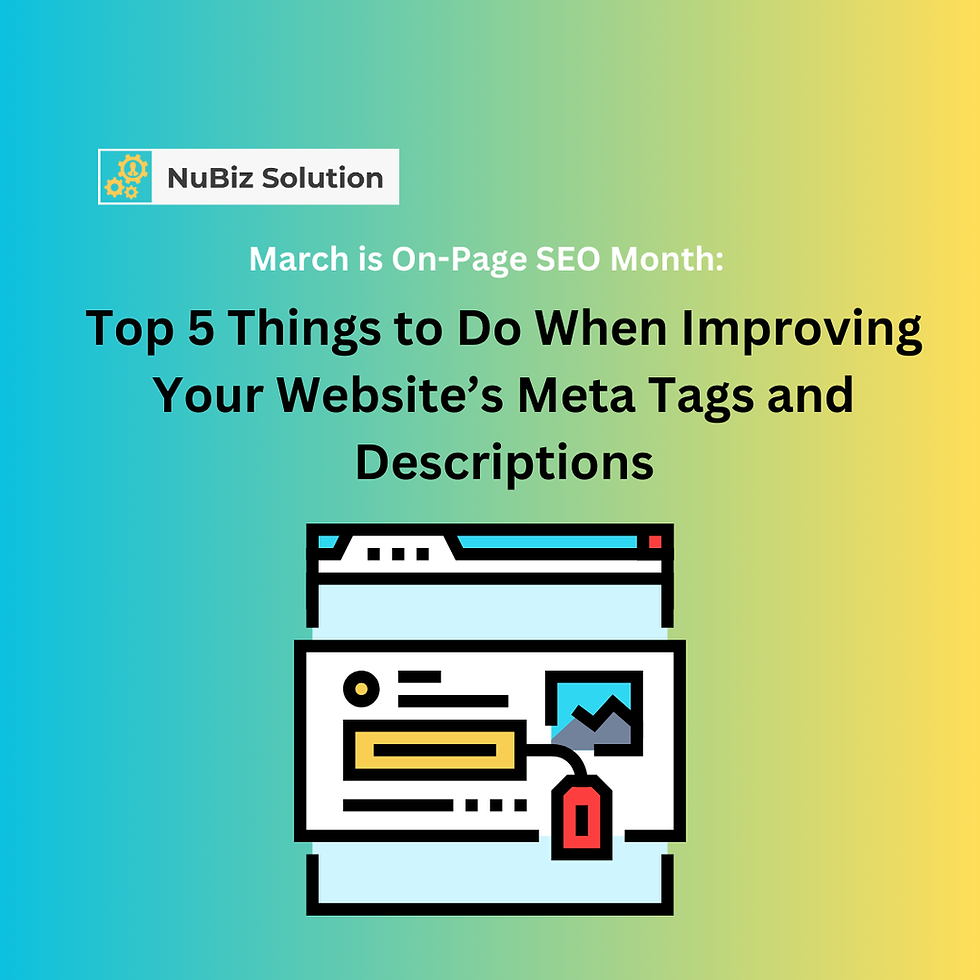Top 5 Things to Do When Improving Your Website’s Meta Tags and Descriptions
- Adnan Siddiqui
- Mar 25
- 2 min read

Meta tags and descriptions are crucial for SEO—they influence click-through rates (CTR), search rankings, and user engagement. A well-optimized meta description can be the difference between a visitor clicking your link or your competitor’s.
Here are the top 5 things to do to improve your meta tags and descriptions for better visibility and conversions.
1. Write Unique, Compelling Meta Descriptions
Your meta description is like a mini-ad for your webpage in search results. It should be concise (150–160 characters), engaging, and include a clear call-to-action (CTA).
✅ Best Practices:
Include your primary keyword naturally
Highlight unique value propositions (e.g., "Free guide," "Step-by-step tutorial")
Use action-oriented language ("Learn how," "Discover," "Get started")❌ Avoid:
Duplicate descriptions across pages
Vague or generic statements
Example:❌ "Learn about SEO tips for better rankings."✅ "Boost your SEO with these 5 proven strategies—download our free checklist today!"
2. Optimize Title Tags for Maximum Impact
Title tags (the clickable headline in search results) are one of the strongest ranking factors. A well-crafted title can increase CTR by 30% or more.
✅ Best Practices:
Keep it under 60 characters (or it gets cut off)
Place the primary keyword near the beginning
Use power words ("Ultimate," "Proven," "2024 Guide")
Include brand name (if relevant)
Example:❌ "How to Improve Your Website SEO"✅ "5 Proven SEO Strategies to Rank Higher in 2024 | [Your Brand]"
3. Use Structured Data (Schema Markup) for Rich Snippets
Rich snippets (star ratings, FAQs, breadcrumbs) make your listing stand out in search results, leading to higher CTRs.
✅ How to Implement:
Use Schema.org markup for:
Articles
Product reviews
FAQs
Breadcrumbs
Test with Google’s Rich Results Test
Example:🔍 A recipe page with 5-star ratings and cooking time in search results gets 3x more clicks than a plain listing.
4. Avoid Keyword Stuffing & Keep It Natural
While keywords are important, over-optimizing can hurt rankings. Google penalizes spammy or repetitive meta tags.
✅ Best Practices:
1-2 keywords max per meta tag
Write for humans first, search engines second
Ensure readability and relevance
❌ Bad Example:"Best SEO tips, SEO strategies, SEO guide, SEO techniques 2024"
✅ Better Example:"Master SEO in 2024 with these expert-backed strategies—start optimizing today!"
5. Regularly Audit & Update Meta Tags
SEO is not a one-time task. Google’s algorithms change, and your meta tags should evolve too.
✅ Audit Checklist:
Use Google Search Console to check impressions/CTR
Identify low-CTR pages and rewrite meta tags
Remove duplicate or missing meta descriptions
Update old posts with fresh keywords
Pro Tip:A/B test different meta descriptions to see which version gets more clicks.
Final Thoughts
Optimizing meta tags and descriptions is a quick win for SEO that can boost rankings and traffic without major technical changes. By following these 5 steps, you’ll make your listings more clickable, improve search visibility, and drive more qualified visitors to your site.
🚀 Action Step:Open Google Search Console today and check which pages have low CTRs—then rewrite their meta descriptions for better performance!
Need help? Book a free SEO audit with our team!




Comments